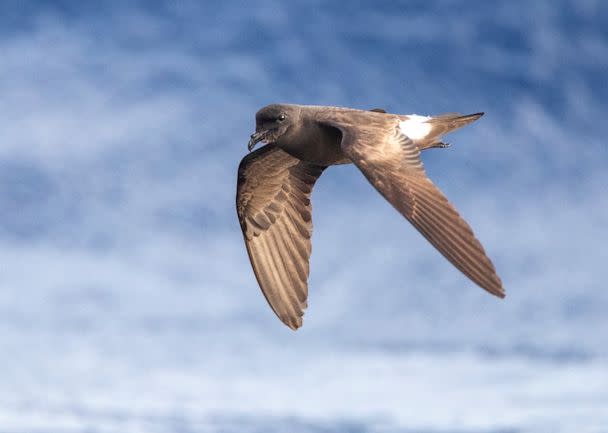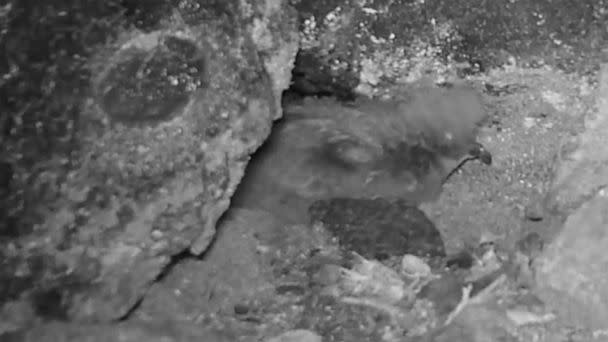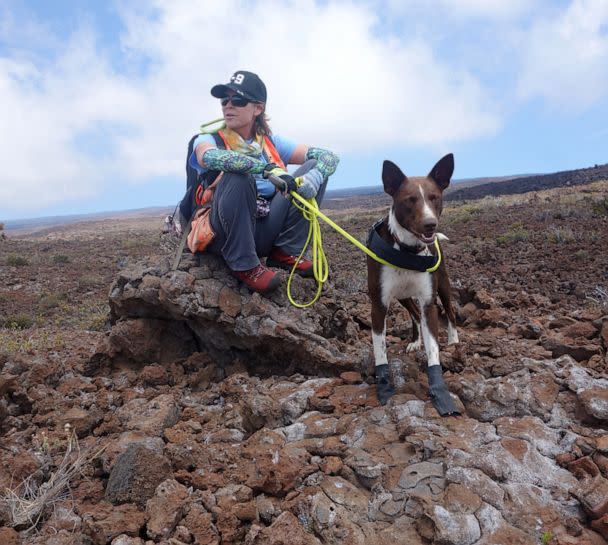Detector dog leads biologists to rare bird never before documented inside Hawaii Volcanoes National Park

Hawaii Volcanoes National Park has been graced with the sight of a rare fledgling that has never been documented inside the preserve.
In September, a McNab shepherd named Slater, a member of the Hawaii Detector Dogs, dogs that have been trained to sniff out invasive species as well as endangered species on the islands, led biologists to the nest of an endangered akeake, or band-rumped storm petrel.
The "cryptic species" has eluded sightings ever since populations began to significantly decline, Sierra McDaniel, the program manager for the Hawaii Volcanoes National Park's natural resources division, told ABC News.
MORE: Shark native to the Arctic found thousands of miles south in the Caribbean
Slater, who was actually on a mission to locate the Hawaiian petrel, another endangered seabird, was able to pick up the scent for another rare species of seabird. In the nest, buried underground in a burrow of the lava on Mauna Loa, the largest volcano in the world, a chick emerged in late October and fledged towards sea about a month later, according to the park.
Before human development, the bird had a "wide" nesting range on the Big Island, McDaniel said. But by the 1980s and 1990s, much of its habitat had been wiped out, with the birds serving as food for predators, including cats, non-native barn owls and mongoose.

Hawaii Volcanoes National Park is equipped with what park officials consider "the largest cat-proof fence," in the country, which may be contributing to allowing such rare species of birds to thrive within its protected lands, McDaniel said. The fence includes a coated chicken wire with a floppy top so that when cats crawl up the side, they can't crawl all the way over the fence and closes off about 644 acres of "cat-free" land, McDaniel said.
The "tenacious" cats on the island are quite determined and have been known to travel up to 10 miles for a chance to snack on the chicks -- and even the parents -- of these endangered species, she added.
"Even in really high elevations, 8,000, 9,000 feet in the middle of these lava fields, and the cats would still travel and eat the seabirds," McDaniel said.
The news comes as the park celebrates the simultaneous eruptions of two of the world's most famous volcanoes: Mauna Loa -- which had previously not erupted since 1984 -- and Kilauea, one of the most active volcanoes in the world.
While the akeake is found throughout the Pacific Ocean basin, the distinct population segment in Hawaii is relatively small, McDaniel said. There are an estimated 150,000 individuals globally, with about 240 pairs known in Hawaii.
The birds are pelagic, meaning they spend most of their life at sea. But they do return to land to nest, and they have "really high site fidelity," meaning they tend to gravitate toward the regions where they were born, McDaniel said.

Their calls have been heard all around the island, but biologists seldom get to see them, McDaniel said.
"Biologists in the park have known of the presence of akeake on Mauna Loa since the 1990s," Forbes Perry, a biologist with the University of Hawaii, said in a statement. In 2019, akeake burrow calls were recorded during acoustic monitoring, indicating nesting, she said.
"It's such a big deal that we've now been able to partner with these dogs that can really help us out and find where these birds are nesting so that we can protect them in that super vulnerable time period," she said.
MORE: Bird watchers flock to NYC park to see technicolor bird rarely seen outside the South
Slater was trained specifically to detect Hawaiian seabirds, and located the akeake nest in just two days, Perry said.
When Slater detects a nest, he will lead his handler toward it or lie down next to it to indicate that there is something important buried beneath, McDaniel said.

Slater was described as "a really good boy" by Jessica Ferracane, public affairs specialist for Hawaii Volcanoes National Park.
Park officials were required to work closely with the U.S. Department of Fish and Wildlife to obtain permission to employ his services, McDaniel said.
Detector dog leads biologists to rare bird never before documented inside Hawaii Volcanoes National Park originally appeared on abcnews.go.com
